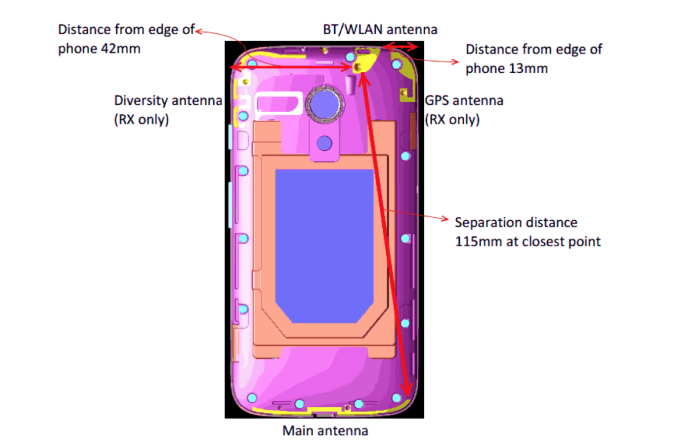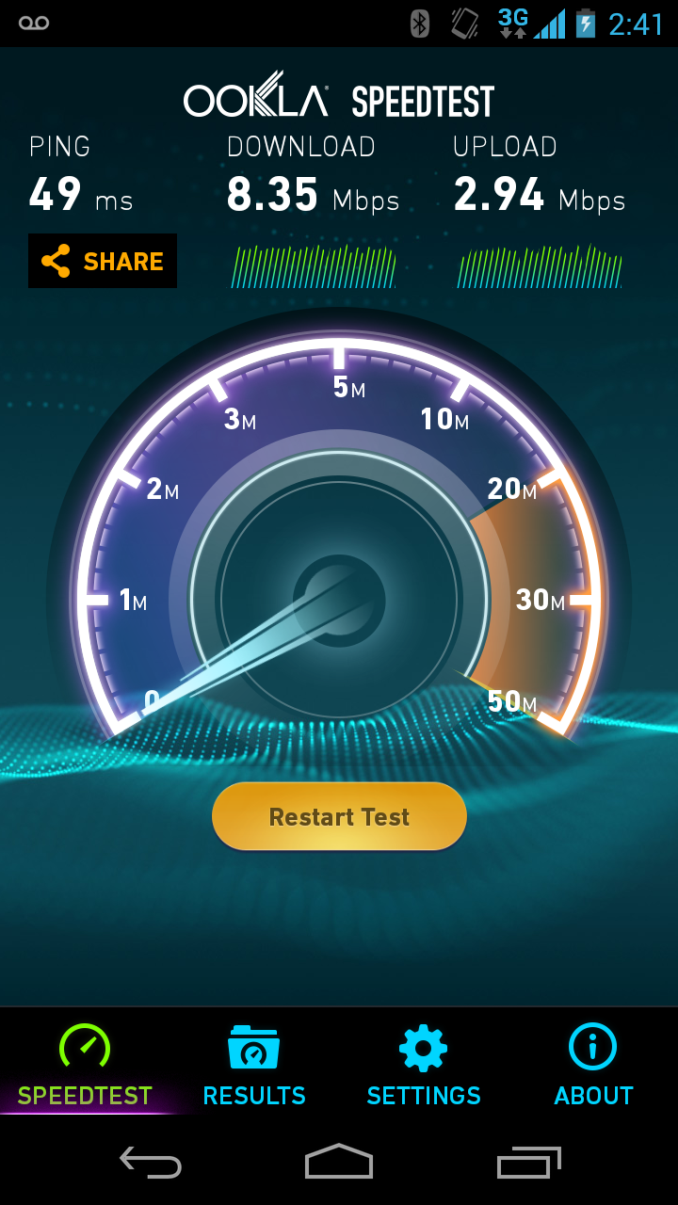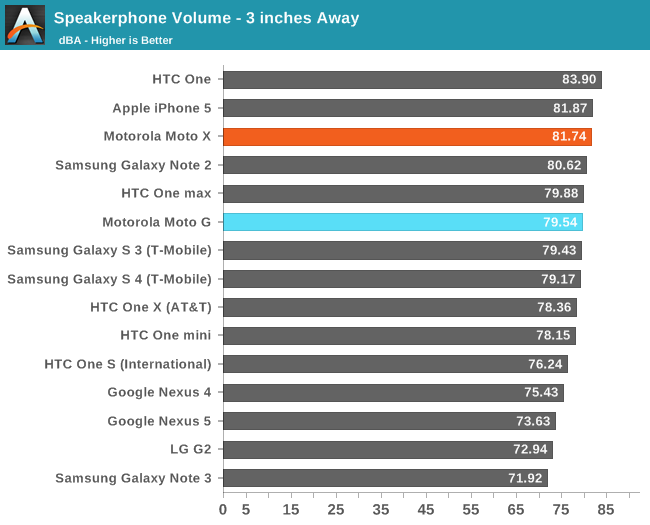Motorola Moto G Review
by Brian Klug on December 18, 2013 2:00 PM EST- Posted in
- Smartphones
- Motorola
- Mobile
- *VA
- Cortex A7
- snapdragon 400
- Moto G
Cellular
The cellular side of the Moto G is an interesting one, at least for those who have kept constantly abreast of wireless banding configurations and the state of mobile RF. At the high end, pentaband WCDMA is now essentially ubiquitous, with parity LTE banding (given the shared nature of ports on the transceiver) and at least a handful more bands for whatever’s appropriate to the region. There’s no global LTE band combination equivalent to quad band GSM or pentaband WCDMA that has emerged quite yet, but it’s getting there, and in the next generation or two we’ll undoubtedly finally see it come to fruition.
|
Moto G (US GSM) |
Moto G (Global GSM) |
Moto G (CDMA) |
|
| Baseband | MSM8x26 - (Up to HSDPA 21.1 Enabled, EVDO Rev.A for CDMA) | ||
| Transceiver | WTR2605/WFR2600 (?) | ||
| GSM | 850/900/1800/1900 MHz | - | |
| CDMA2000 | BC: 0/1/10 | - | 850, 1900 MHz |
| WCDMA |
850, 1700/2100 (AWS), 1900 MHz (Bands 2, 4, 5) |
850, 900, 1900, 2100 MHz (Bands 1,2,5,8) |
- |
| LTE | - | - | - |
The Moto G however comes in a number of different flavors with different band combinations – there’s US GSM, Global GSM, and CDMA. I also suspect there’s at least one more dual SIM variant that we haven’t seen crop up just yet (Update: Apparently this exists already, XT1033 is the dual SIM variant, thanks @evefavretto). On the back case of Moto G there’s a space whose shape matches the microSIM tray at top, and on the board there’s a shield covering pads that are undoubtedly for a microSIM. Interestingly enough Motorola sampled me the Global GSM variant of the Moto G which lacks Band 4. I’ve been using it on T-Mobile successfully however thanks to the relative ubiquity of the 1900 MHz WCDMA carrier in my market. The US GSM variant of the Moto G trades Band 4 for 1 and 8 (2100 and 900 MHz), two popular bands internationally. I’ve seen Moto G erroneously listed as being a pentaband WCDMA phone, which it unfortunately isn’t.

Primary Rx/Tx at bottom, Diversity Rx up top, WLAN/BT, GNSS Rx
Moto G does offer a leg up with receive diversity for CDMA1x/EVDO and HSPA+, something that some HSPA+ flagships from this generation amazingly enough still don’t include. The transceiver is WTR2605 for the primary Rx and Tx ports, and WFR2600 for the additional Rx diversity path. I have no idea what the port configurations look like for WTR2605, but I’d imagine it looks like a cut down WTR1605 of some kind. I have a suspicion that WTR2605 was designed for a quad band UMTS configuration with Bands 1,2,5, and 8, so it might indeed already be port limited in the Global GSM Moto G variant. I also wouldn’t be surprised if there’s some ready made front end module at the front of the whole thing.
Moto G arrives without LTE and instead offers up to single carrier HSPA+ with 64QAM, for up to 21 Mbps on the downlink. Although MSM8x26 itself has a modem block capable of up to dual carrier HSPA+ and category 4 LTE, it seems as though Motorola went for single carrier HSPA+ in the Moto G for time to market reasons, with the LTE and dual-carrier HSPA+ enabled software tree likely slotting in a quarter later than the initial code drop with single carrier HSPA+.


Not bad for single carrier HSPA+ on T-Mobile USA
I’ve been pretty pleased with the cellular performance of the Moto G, even using the variant that lacks Band 4 on T-Mobile USA. Not having LTE made me initially skeptical of it getting operator traction in the US, but it seems as though Motorola has actually had success at least on some prepaid tiers. I’ve been spoiled with LTE devices for a long time now, but single carrier HSPA+ is absolutely still survivable.
WLAN
WiFi connectivity on Moto G is single band 2.4 GHz 802.11n with BT 4.0 and FM receive. On the Moto G, that connectivity is courtesy the new WCN3620 BT/FM/WLAN RF combo chip in a wafer scale package. We’ve now seen WCN3660, the initial dual band combo, then WCN3680 which added 802.11ac, and now WCN3620, the cost reduced version which is single band 802.11n and no doubt offered at a competitive price point with the rest of the platform.
The WLAN/BT stack doesn’t do any antenna sharing and instead has its own transmit and receive path on the top of the Moto G. I don’t have any complaints about WLAN range on the Moto G.
To evaluate performance we turn to the same iPerf test same as always. I was able to attach the Moto G to my network at the 65 Mbps PHY rate that corresponds to long guard interval with a 20 MHz channel.

Performance is pretty decent at just over 50 Mbps. It’s a significant delta over the latest devices with dual band 80 MHz 802.11ac support, but again, totally solid relative to the tier it’s in.
Speakerphone and Noise Canceling
Speakerphone on the Moto G seems to be a big chamber if you take the back off, but there’s a relatively small seal against the whole affair, although the grille has larger holes than Moto X’s relatively tiny ones. Loudness is competitive, but unsurprisingly short of Moto X.

I’d describe Moto G’s speaker as decent, not overly loud or rich sounding.
Dual microphone noise suppression is still a somewhat notable feature at the midrange. In the case of Moto G, Qualcomm’s Fluence package is used in a configuration with the primary microphone at bottom and secondary at very top. I did some digging and also found that Moto G is using Qualcomm’s WCD9302 audio codec which we haven’t seen before, again a more midrange variant. I’ll leave the earphone/line out audio testing for Chris to evaluate.
Noise suppression on the Moto G is decent, but seems to have longer adaptation time than the Moto X. Using the exact same setup, I definitely noticed better rejection on Moto X as well, with less noise being passed through at the same volume level. I should also note that the Moto G does not appear to be AMR-WB enabled on T-Mobile.
GNSS
GNSS onboard the Moto G is the same Gen 8B as we’ve seen on 8974, which translates to support for GPS (USA “Navstar”), GLONASS (Russia), and Beidou (China), although the spec table for Moto G only lists GPS and GLONASS, leading me to believe Beidou might be reserved for devices destined for China. There’s a discrete antenna for GNSS on the Moto G, and I had no issues with getting fast, accurate 3D fixes. I remain impressed with Qualcomm’s GNSS which obviously benefits from integration right into the SoC.










120 Comments
View All Comments
haukionkannel - Wednesday, December 18, 2013 - link
True, but this is not power user phone. The Noto X is for that purpose. For normal mister Smith this is very good phone indeed. But so is/are allso Lumia 52x phone(s), so comparison would be nice as someone above allready said.fic2 - Wednesday, December 18, 2013 - link
My girlfriend has a 521. It is a nice phone, but the HUGE problem is having to do a hard reset every time there is an upgrade. A hard reset looses all settings. And MS seems incapable of doing a backup that actually backs up everything. The stuff they do backup has to go to "the cloud" (to be datamined by them and the NSA). And when you do a restore it is a one-shot and can only be done over 3G since wireless isn't enabled at the time.Because of this I am thinking about getting her a Moto G.
skiboysteve - Saturday, December 21, 2013 - link
What are you talking about? WP updates are OTA incremental and never require a hard reset...shaduck007 - Saturday, January 4, 2014 - link
thanks for Mentioning the Lumia, it's 1/3 the price of the MOTO G.Thinking of what is the best value!!
Sam
sephirotic - Wednesday, February 5, 2014 - link
If this is not a power use phone then why add quad core, instead of a dual core processor, and a 720p screen? Witch is cheaper and more usefull, that or a SD card slot?grayson_carr - Wednesday, December 18, 2013 - link
Are power users interested in this phone as their main device? If 8 or 16GB was fine for the flagship Nexus 4 13 months ago, I think it's fine for a low cost phone now.grayson_carr - Wednesday, December 18, 2013 - link
Lets not forget, the average consumer still buys a 16GB iPhone or 16GB Galaxy S4 and doesn't put in a microSD card in the case of the GS4.fokka - Wednesday, December 18, 2013 - link
source? regarding the s4 i mean.flyingpants1 - Wednesday, December 18, 2013 - link
The average consumer doesn't actually use their phone for more than an hour or two a day, leaving it in sleep state 95% of the time and somehow assumes this means it has "good battery life".The average consumer does not store hours of movies on their phone, or watch movies on their phone at all.
The average consumer also can't see the difference between a 5mp camera and a 13mp camera.
The average consumer sees almost no benefit from 7mbit HSPA+ to 30mbit LTE.
The average consumer doesn't care about front speakers or waterproofing.
The average consumer doesn't use a wireless charger.
The average consumer CANNOT. SEE. The difference between a 540x960 display and a 1080p display.
The average consumer doesn't run more than a couple apps at the same time.
The average consumer doesn't care about read/write speeds of the NAND on their phone.
The average consumer doesn't know the difference between LCD and AMOLED.
Smartphones are ubiquitous now. Every grandma has a $0 iPhone that they don't know how to use. This doesn't mean we should stop making things better. For god's sake don't make us all suffer on behalf of your demented relatives.
apertotes - Wednesday, December 18, 2013 - link
it was not fine for nexus 4. And I explicitly said that it was not a poweruser scenario at all.